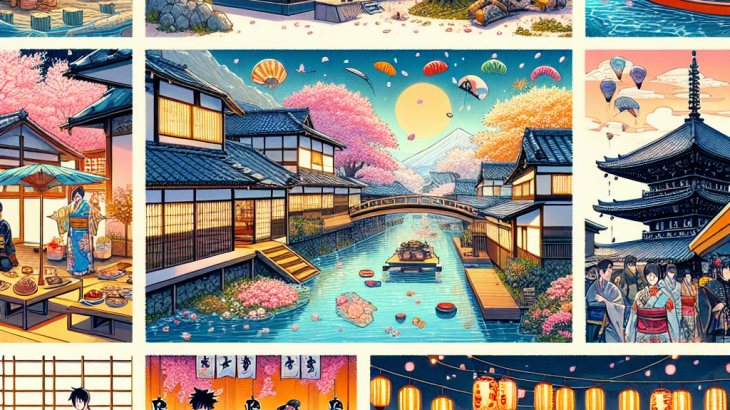The Influence of Japanese Culture in Anime World-Building
Anime is a fascinating art form, captivating millions with its compelling stories, unique art style, and complex characters. But one of the most intriguing aspects of anime is its world-building. What sets anime apart from other forms of storytelling is its profound reliance on Japanese culture to create immersive and imaginative worlds. Let’s dive into how Japanese culture influences the intricate process of anime world-building.
Traditional Japanese Elements in Anime
One of the most noticeable aspects of Japanese culture in anime is the frequent incorporation of traditional elements. These can range from historical settings, mythologies, festivals, and even ancient samurai codes.
- Historical Accuracy: Many anime series, such as “Rurouni Kenshin” and “Samurai Champloo,” meticulously recreate historical periods, like the Meiji era, offering viewers a glimpse into Japan’s rich past.
- Mythological Creatures: Yokai, ghostly beings from Japanese folklore, often make their appearance in anime, such as “Natsume’s Book of Friends” and “Spirited Away,” adding a layer of mysticism.
- Traditional Practices: Samurai culture, tea ceremonies, and festivals like Tanabata often form the backdrop of many anime, blending the spiritual and mundane seamlessly.
Japan’s Urban and Rural Landscapes
The juxtaposition of Japan’s bustling cities and serene countryside deeply influences anime settings. These contrasting environments play major roles in storytelling and character development.
- Urban Settings: Anime like “Tokyo Ghoul” and “Durarara!!” vividly portray urban life in Tokyo, from crowded streets to neon lights, highlighting both the glamour and isolation of city life.
- Rural Beauty: “My Neighbor Totoro” and “Silver Spoon” present idyllic rural settings, emphasizing close-knit communities, agricultural life, and the beauty of nature.
These contrasting settings allow anime creators to explore a wide range of themes and atmospheres, providing depth and diversity to their stories.
Food Culture in Anime
Food plays an essential role in Japanese culture, and this focus is prominently reflected in anime. From intricate bento boxes to ramens that look good enough to eat through the screen, food is more than just sustenance in anime; it’s a storytelling tool.
- Daily Life: Series like “Shokugeki no Soma” and “Sweetness & Lightning” revolve around cooking and the joy of sharing meals, reinforcing the importance of food in bringing people together.
- Cultural Events: Festivals and seasonal foods are often depicted, exposing viewers to the diversity and richness of Japanese culinary traditions.
This detailed portrayal of food helps build a more immersive and authentic world that resonates deeply with viewers.
Language and Communication
The Japanese language itself influences anime world-building significantly. Puns, honorifics, and varied speech patterns offer additional textures to characters and settings. These linguistic nuances often don’t translate directly but add a layer of cultural authenticity that fans appreciate.
- Puns and Wordplay: Series like “Gintama” thrive on linguistic humor, making clever use of Japanese language quirks.
- Honorifics and Formality: Respect and social hierarchy are reflected in how characters address each other, adding depth to their relationships.
Understanding these elements can greatly enhance one’s appreciation of the story and character dynamics.
The Role of Spirituality
Japanese spirituality, centered around Shinto and Buddhist practices, also deeply influences anime narratives. Themes of karma, reincarnation, and the interconnectedness of all things are frequently explored.
- Shinto Elements: Torii gates, shrines, and rituals are common in series like “Noragami,” where gods play critical roles in human affairs.
- Buddhist Concepts: Animes such as “Shonen Onmyoji” delve into concepts of rebirth and enlightenment, adding philosophical weight to the storylines.
Spirituality provides a rich vein of material for anime creators, offering profound and thought-provoking narratives.
Discover More Anime Worlds
Would you like to dive even deeper into the captivating world of anime? Explore a variety of anime content and keep up with the latest updates on some of the top Anime Telegram Channels. From recommendations to reviews, these channels offer a treasure trove of anime-related information.
In summary, the influence of Japanese culture on anime world-building is profound and multifaceted. From historical and traditional elements to food culture and spirituality, these cultural aspects create rich, immersive worlds that captivate and resonate with audiences worldwide. Whether you’re a seasoned otaku or a curious newcomer, understanding these influences can greatly enhance your appreciation of anime as an art form.
Anime is not just entertainment; it’s a window into the soul of Japan, offering endless adventures waiting to be explored.
